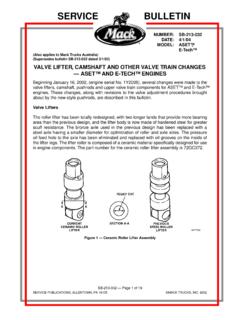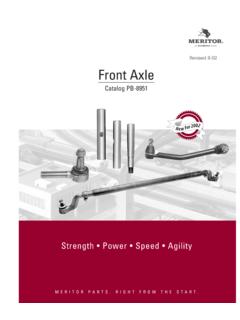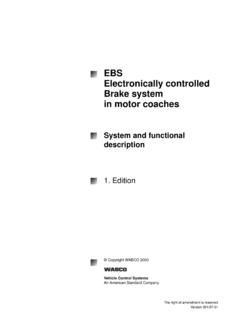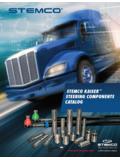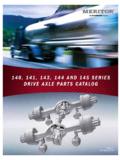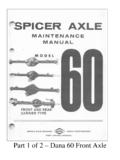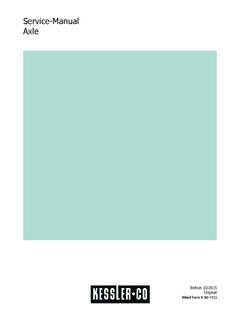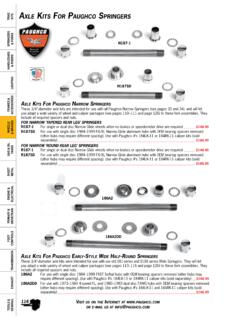Transcription of Meritor Rear Axle Seals
1 C:\Documents and Settings\Administrator\Local Settings\Temporary Internet Files\ \O7VN6GL9\22-04[1].doc System: Axles, Driven Bulletin #: 22-4 Date: March 9, 2005 Meritor rear axle Seals Accompanying this bulletin is information on the new Multiple Lip Seals used in the Meritor rear drive axles. Please utilize this information when replacing Seals in the Meritor rear ends. The required tools for this procedure will be shipped as received. Keep in mind that the warranty coverage on these Seals is 3 years or 350,000 miles, whichever occurs first. If you have any questions, feel free to contact me at Location # 24. Thank you, Walter Kirkland Jr. Tallahassee Maintenance Department Attachments: Attachment 1: Meritor Technical Bulletin # TP-0446 Attachment 2: Meritor Product Information Letter # 430 Attachment 3: Meritor General Parts Bulletin # GP-999 TP-0446 Issued 02-05 Technical BulletinInstalling a Multiple-Lip seal (MLS) onto Meritor 14X/16X/18X Single and 14X/16X/18X/38X Tandem Drive AxlesDoes Not Apply to Meritor Front Drive Steer Axles, Transfer Cases or Other Drive AxlesNot Listed in This XX-051 Technical BulletinTable A: Driver and Sleeve Part NumbersForward input and output Seals must be serviced with the seal and sleeve.
2 The service part number provides both when your application carefully before installing the multiple-lip to Obtain Additional Maintenance and Service InformationRefer to technical bulletin TP-0531, Multiple-Lip seal Installation, for instructions on CD. Also, refer to technical bulletin TP-0534; Maintenance Manual 5A, Single-Reduction Differential Carriers; Maintenance Manual 5E, Tandem axle Forward Carriers and Single axle Carriers, Including Double-Reduction Carriers; or Maintenance Manual 5L, Single-Reduction Forward Differential Carriers on Tandem and Tridem Axles. To obtain these publications, call ArvinMeritor s Customer Service Center at 800-535-5560, or visit the Tech Library on our website at InformationThis technical bulletin provides the recommended procedure for installing Meritor multiple-lip Seals (MLS) on Meritor 14X/16X/18X single and 14X/16X/18X/38X tandem drive axles.
3 These instructions do not apply to front drive steer axles, transfer cases or other drive axles not listed in this new Meritor multiple-lip Seals feature a separable sleeve installed onto the yokes at the tandem forward- rear input and forward- rear output positions. No sleeve is used on the rear - rear of the new Seals requires a set of four seal drivers and two sleeve drivers. Refer to Table A for part ToolsThere are six new installation drivers required for replacement of the multiple-lip axle yoke Seals . Figure 1. A sleeve driver and seal driver for the forward- rear input A sleeve driver and seal driver for the forward- rear output Two model specific seal drivers for the rear - rear inputTo obtain these sleeves, Seals and drivers, call ArvinMeritor s Commercial Vehicle Aftermarket at 1 axle Model and PositionSeal Service Part NumberPrevious seal Part NumberSeal DriversSleeve Drivers14X/16X/18X/38X Forward- rear Unit Input (FUI)A1-1205X2728A-1205R25922728T12728T2 14X/16X Forward- rear Unit Output (FUO)A1-1205Y2729A-1205P25902729T12729T2 14X rear - rear Unit Input (RUI)A1-1205Z2730A-1205N25882730 TNot Required Sleeve is unitized16X/18X rear - rear Unit Input (RUI)A1-1205A2731A-1205Q25912731 TNot Required Sleeve is unitizedFigure 14005371a2729T12730T2731T2729T22728T1272 8T2TP-0446 Issued 02-05(16579/24240)Page 2 Copyright ArvinMeritor, Inc.
4 , 2005 Printed in the USAR emovalWARNINGTo prevent serious eye injury, always wear safe eye protection when you perform vehicle maintenance or the vehicle on a level surface. Block the wheels to prevent the vehicle from moving. Support the vehicle with safety stands. Do not work under a vehicle supported only by jacks. Jacks can slip and fall over. Serious personal injury and damage to components can a rear - rear input, if you partially or fully install a yoke and then remove it for any reason, remove, discard and replace the seal with a new seal . If a seal or sleeve is removed after partial or full installation, discard the seal or sleeve and replace it with a new seal or sleeve. Damage to components can safe eye the vehicle on a level surface. Set the parking brake. Block the wheels to prevent the vehicle from a jack to raise the vehicle so that the wheels to be serviced are off the ground.
5 Support the vehicle with safety the drive a flange bar or place a yoke bar over the input or output yoke to hold the yoke or flange while you remove the nut. Always use a flange or yoke bar during removal and installation of the flange yoke nut to prevent damage to the gearing. Figure 2 WARNINGUse a puller tool to remove the yoke or flange from the shaft. Do not use a hammer or mallet, which can damage components and cause vibration in the driveline. If this occurs, the driveline can separate from the vehicle during operation. Serious personal injury and damage to components can the yoke nut and washer. Use a puller tool to remove the yoke or flange from the shaft. Do not use a hammer or mallet, which can damage components. Figure 3 CAUTIONOn axles that have the bolt-on deflector on the forward- rear output shaft bearing cage, the deflector must be removed and discarded.
6 The new forward output sleeve will not assemble correctly to the new output seal with the bolt-on deflector in place. Remove the deflector from the output shaft bearing cage and reassemble the output cage hex-head capscrews and washers according to the appropriate maintenance manual instructions. Damage to components can remove the pinion seal from the yoke or carrier. Do not damage the seal bore when you remove the seal . Do not allow dirt or grease to contaminate the seal bore or adjacent a seal sleeve is installed onto a yoke, remove the sleeve using a bearing puller. Do not reuse the seal the yoke seal area for damage that could cause lubricant leaks after you install the seal . Use emery paper or an equivalent product to remove scratches, nicks or burrs 2 YOKE BAR1003451bFigure 31002733aYOKEPULLERTP-0446(16579/24240)I ssued 02-05 Printed in the USAC opyright ArvinMeritor, Inc.
7 , 2005 Page 3 InstallationWARNINGS olvent cleaners can be flammable, poisonous and cause burns. Examples of solvent cleaners are carbon tetrachloride, and emulsion-type and petroleum-base cleaners. Read the manufacturer s instructions before using a solvent cleaner, then carefully follow the instructions. Also follow the procedures below. Wear safe eye protection. Wear clothing that protects your skin. Work in a well-ventilated area. Do not use gasoline, or solvents that contain gasoline. Gasoline can explode. You must use hot solution tanks or alkaline solutions correctly. Read the manufacturer s instructions before using hot solution tanks and alkaline solutions. Then carefully follow the the ground and polished surface of the yoke journal using a clean shop towel and a safe cleaning solvent. Do not use abrasive cleaners, towels or scrubbers to clean the yoke or flange surface.
8 Do not use the yoke seal area for damage that could cause lubricant leaks after you install the seal . Use emery paper or an equivalent product to remove scratches, nicks or burrs the deflector, if equipped, onto the yoke. You must install the deflector before you install the sleeve into the yoke. Figure 4 WARNINGO bserve all warnings and cautions provided by the press manufacturer to avoid damage to components and serious personal not hit steel parts with a steel hammer. Pieces of a part can break off. Serious personal injury and damage to components can a light coat of axle oil to the yoke seal journal. Position the sleeve into the forward- rear axle output yoke sleeve driver. Do not touch the greased areas of the sleeve. The sleeve must be kept clean prior to assembly into the seal . Use an arbor press and the appropriate driver to install the sleeve into the yoke.
9 Verify that the sleeve is fully-seated in the yoke to prevent damage to components. Figure yoke must be fully pressed into the sleeve driver until the end of the yoke bottoms out in the sleeve driver. This will correctly position the sleeve on the yoke. When correctly seated, the forward- rear output sleeve is positioned (5 mm mm) from the end of the yoke. Figure 6. If you do not have a press: Position the yoke on a five-inch (127 mm) spacer on a workbench. Use a dead-blow hammer and the appropriate driver to install the sleeve into the yoke. Figure a light coat of axle oil to the yoke seal journal. Position the sleeve into the forward- rear axle input yoke sleeve driver. Do not touch the greased areas of the sleeve. The sleeve must be kept clean prior to assembly into the seal . Use an arbor press and the appropriate driver to install the sleeve into the yoke.
10 Verify that the sleeve is fully-seated in the yoke. Figure yoke must be fully pressed into the sleeve driver until the end of the yoke bottoms out in the sleeve driver. This will correctly position the sleeve on the yoke. When correctly seated, the forward- rear input sleeve is positioned ( mm mm) from the end of the yoke. Figure 6. If you do not have a press: Position the yoke on a five-inch (127 mm) spacer on a workbench. Use a dead-blow hammer and the appropriate driver to install the sleeve into the yoke. Figure 44004889aYOKEDEFLECTOR,IF EQUIPPEDSLEEVEDRIVERTP-0446 Issued 02-05(16579/24240)Page 4 Copyright ArvinMeritor, Inc., 2005 Printed in the USAF igure 5 Figure 6 Figure 7 Figure 8 CAUTIONHold the sleeve and seal only on the outer diameter. Do not touch the greased inner diameter of the seal and the greased area of the sleeve. This can contaminate the seal and cause a leak between the shaft and the seal .



